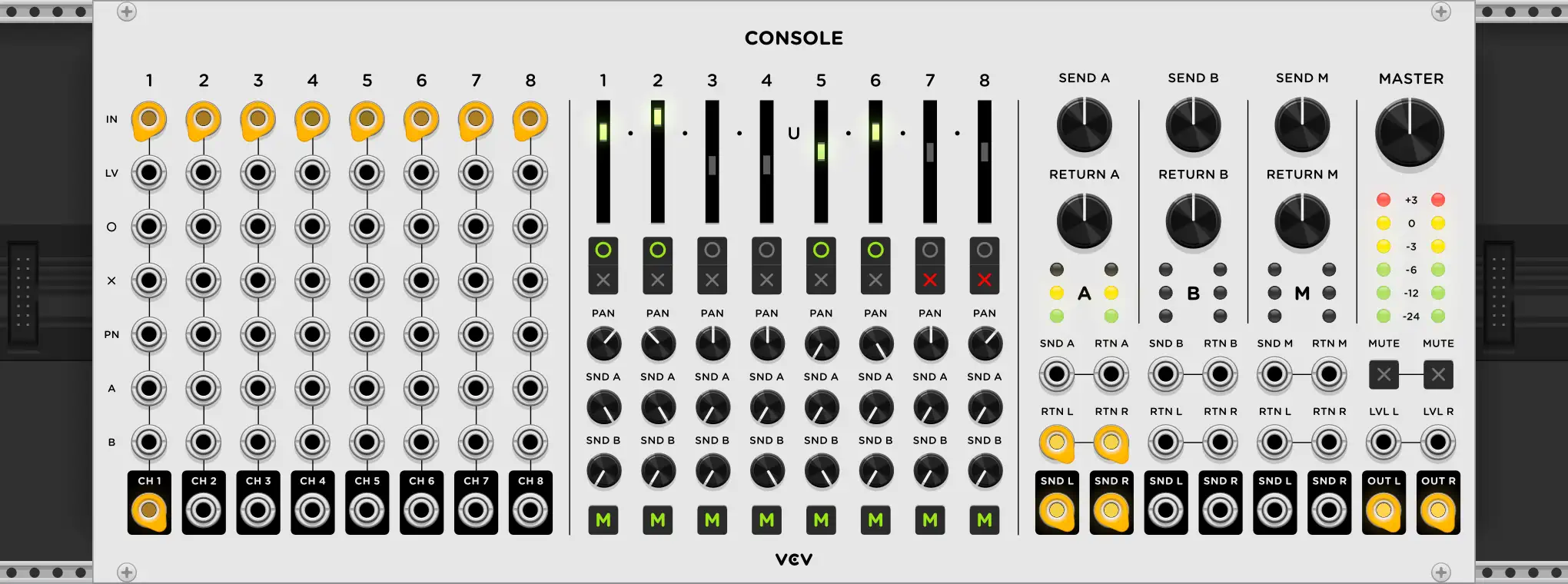
8-channel mixer with 3 send/return buses, built-in VCAs, constant-power panning, and soft output saturation.

VCV Console
Console is a fully-featured mixing console similar to those found in recording studios. It is DC coupled, so both audio and CV signals can be processed.
Patchbay
Each channel includes a patchbay, separated from its channel strip controls to reduce clutter.
The LV input controls the built-in VCA for each channel. The VCA accepts the range 0V to 10V, with 10V applying a gain of 1.
The O (solo) and X (mute) trigger inputs toggle the solo and mute state of the channel when a trigger at least 2V high is detected.
The PN input applies a CV bias to the current position of the pan knob. When the pan knob is at 12-o’clock, a range of -5V to 5V adjusts the pan from full-left to full-right. If the pan knob is hard-left, a range of 0V to 10V gives this same result.
The A and B inputs adjust the volume knobs of Send A and Send B through a CV signal. They behave as VCAs for the send audio when the send knob is hard-left. However, when the send knob is turned up, the send CV signal adds or subtracts to the knob position. For example, a small fluctuating CV signal with the send knob at a high position applies tremolo to the send audio.
Each CH output clones the audio signal, post-VCA, post-mute/solo, but pre-fader.
Channel Strip
Each fader can apply up to +6dB of gain to its channel. The fader is illuminated when audio is passed through the channel, with its brightness proportional to the audio level, post-fader.
Click the O (solo) and X (mute) buttons to toggle the solo/mute state.
The PAN knob adjusts the balance of the mono channel in the stereo send and master outputs. To preserve a constant sound power level, a boost of roughly +3.5dB is applied when the channel is panned hard-left or hard-right. To mix stereo audio, you may use two channel strips with the left and right channels panned hard-left and hard-right.
The SND A and SND B knobs adjust the volume of channel that is routed to the Send A or Send B buses. The M button toggles routing to the Send M (master) bus.
Buses
When a signal is routed from a channel strip to Send A/B/M, it is attenuated with the SEND A/B/M knobs, which can be biased with the SND A/B/M CV inputs. The signal is then routed to the stereo SND L and SND R outputs for external processing.
After processing, the stereo signal can be routed to the RTN L and RTN R inputs and attenuated by the RETURN A/B/M knobs and RTN A/B/M CV inputs. The level of the signal post-attenuation is displayed on the VU meter, and the signal is finally mixed into the master bus.
The MASTER output section includes a level knob with roughly +11dB of gain. The left/right channels can be muted separately and can be attenuated through separate VCAs controlled by the LVL L and LVL R inputs.
While the intention is to use a bus’ send and return channels with an external processor like reverb or delay, the send section and return section can instead be treated independently. For example, you can use the three return buses as stereo channel strips with their own attenuators and VU meters, ignoring the send outputs. Or, you can use the sends as surround sound outputs, along with the master output. In this case, you can adjust the back/front volume with the SEND A/B attenuators on each channel strip.